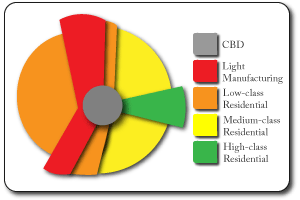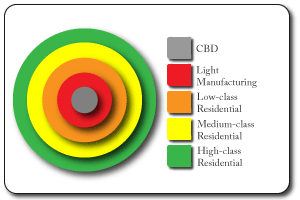Concentric Zone Model/ Burgess Model
- Based on the city of Chicago (an MEDC)
- Based on the idea that land value is the highest in the center of a city (competition for space)
- Designed in 1924 by Ernest Burgess
- Shows the distribution of social groups within urban areas
- The focus of the model is the Central Business District (CBD) and the zones that spread outward from it.
Criticisms:
- It assumes land and resources are equal in all directions, resulting in the concentric rings. In reality this is not the case.
- An advancement in transportation and information technology has meant the zones are no longer clear. People have now chosen to live and work outside the city center.
- There is NO such thing as a typical city
perhaps....?
Perhaps the Hoyt Sector Model is more realistic
- This model was based on the concentric ring model but took into account the effect of transport routes, this is because industry often chooses specific transport routes (to bring in raw materials or export the finished goods)
- The low class residential sector is a lot more spread out and closely linked to the manufacturing zone. This is because lower paid workers cannot afford to live in the high-class residential zone so they live in the cheaper sectors (more noise and higher pollution).

ACTIVITY: Here students could given worksheets which label the sectors, students could start by describing sectors, comparing the Hoyt and Burgess model and brainstorm ideas about the size and distribution of the sectors in the Hoyt Sector Model. For example: I think the CBD has shifted to the right because when the city was expanding it started to move towards the countryside due to a lack of space in the other direction. The original CBD may have deteriorated over time.
Zones
Central Business District (CBD)
The CBD is located in the middle of a city/town because it is a central location for transport links to converge, it is easily accessible for workers, shops and businesses. Land use of a CBD is as follows
Zones
Central Business District (CBD)
The CBD is located in the middle of a city/town because it is a central location for transport links to converge, it is easily accessible for workers, shops and businesses. Land use of a CBD is as follows
- Leisure and recreation - parks, sports centres, spa's
- Residential - houses and flats
- Transport - railway, road, airports
- Business and Commerce - offices, shops and banks
- Industry - factories, warehouses and production centres
Identifying the CBD
- Mulltistory buildings
- Expensive land
- Department stores
- Shopping centres and pedestrian areas
- Museums and historical buildings
- Offices, finance and banks
- Transport centres
Sometimes known as 'the twilight zone', it is typically found next to the CBD.
- Terraced housing is popular and these were build to house the factory workers who worked nearby, these factories have since shut down but the terraced 'grid' remains.
- Many inner cities declined due to unemployment and other socioeconomic factors e.g. St. Anns in Nottingham.
- Many of these areas have resulted in gentrification, which refers to the a recent regeneration of the area, making them appeal to young professionals wanting to live near the CBD
The Suburbs ( middle-class residential)
Outside the CBD and the 'twilight zone' is the suburbs, land values are slightly lower due to distance from the CBD; demand for space is decreased and so house sizes increase, many with a garden however due to the desirability of the houses, some areas can be very expensive.
- Homes are either detached or semi-detached.
- Arranged in avenues or cul-de-sacs
- Facilities such as schools, parks and places of worship are present
- Many are served by a local supermarket
- Popular to commuters as there is easy access to CBD.
Urban Rural Fringe
'Where town meets country,' the urban rural fringe is found at the edge of a town or city. Land use is very varied; housing, golf courses and business parks. The mixed land use often causes conflict and the people have different needs and interests.
Mini Case Study: Terminal 5 Heathrow.
Ask students to research T5 at Heathrow and in particular to focus of the economic, social and political arguments for and against it being built.



No comments:
Post a Comment